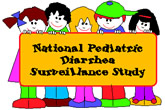National Pediatric Diarrhea Surveillance Study
 Objectives
Objectives
To determine a) the prevalence of specific bacterial, viral and protozoal pathogens in the stools of 1000 healthy children between 6 months and 3 years of age who are representative of US children with respect to geography, family income, and race, b) the incidence of acute diarrheal illness occurring among these children (including illness not severe enough to require medical attention), and c) the incidence of infection with specific bacterial, viral and protozoal foodborne pathogens associated with clinical illness.
To characterize the gastrointestinal illnesses that occur in these children, their duration, treatment, and sequelae occurring within two months of acute illness.
To identify risk factors for diarrheal illness and infection with specific foodborne pathogens in these children. Risk factors to be studied include consumer practices related to food (and water) purchasing, handling, storage, and cooking in the home.
Methods
This is a multi-center, prospective cohort study. Eligible healthy children are identified and enrolled by office-based primary care physicians from an established nationwide network. A baseline interview is conducted with the parent of each enrolled child shortly after enrollment. Each child is then followed for eight months with monthly follow-up to monitor for occurrence of diarrheal illness and to obtain detailed information for each occurrence. Follow-up at months 1, 3, and 5 is by postcard, and follow-up at months 2, 4, 6, and 8 is by telephone. Stool specimens are collected from each subject at baseline and analyzed for the prevalence of enteric pathogens. Additional stools are collected from each child who develops a diarrheal illness during the follow-up period, and are tested for specific pathogens.